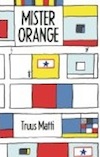
The year: 1943. The place: Manhattan. Linus Muller works at the family grocery store in the east 70s. When his oldest brother, Albie, leaves to fight in World War II, Linus takes over the grocery deliveries. One of his customers is an artist from somewhere in Europe who arranges to have a crate of oranges delivered every other week
- ISBN: 9781592701230
- Author: Matti, Truus
- Published: 2013 , ENCHANTED LION BOOKS
- Themes: Family, Friendship, immigrant, New York, World War II
- Descriptors: Historical Fiction, Intermediate (ages 9-14)
- No. of pages: 156

Yoo Kyung
An interesting combination of different themes takes the audience on a quite delightful reading journey. In the book, set in New York in the 1940’s, there is a focus on brotherhood, war, art, and good and bad friendships. All of these, in Mr. Orange, create unique and informative dynamics. As a non-New Yorker, I often thought about the small business/store culture on the busy streets of New York City as quite monumental. Perhaps the fruit store that Linus’ family runs symbolizes an important cultural iconic representation of immigrant life in the New York of the 1940’s. Although Mr.Orange is historical fiction, many aspects of the story feel quite contemporary. For example, many military families have experienced the departure of a family member to a war zone like Linus does. The main protagonist’s big brother, Alfie, is like a hero to Linus when he is shipped off to war. The absence of Alfie leads Linus to take over Alfie’s job of delivering fruit to customers. What I like about the story is that when someone important is absent, someone else fills his life with a new relationship. In this story Mr. Orange is an unusual adult. Mr. Orange is the nickname that Linus’ father comes up with for his foreign named customer because Linus cannot accurately remember Mr.Orange’s real name. Linus’ new relationship with Mr. Orange, who is the Dutch artist named Piet Mondrain, helps Linus to grow as the war heavily impacts his family. In reading Mr. Orange, I realized how I had stereotyped the 1940’s as a “no-fun” era preoccupied with WW II. Super hero comic books were popular in 1940’s and, like children in 1940’s, children today get just as excited about a pair of new shoes. I appreciate that the story reminds us that childhood is childhood despite differing expectations of time and place. I also appreciate Matti’s writing. In her writing, the nuances and narrations keep reminding me that I am reading quality children’s literature. This book is extraordinarily delightful. Maybe “delightful” is not quite the right word I am looking for, reminding of how Linus points out insufficiency in word choices. “There are words for colors, but not for smells. The way this orange smells for instance.” Linus held it up. “There’s just no word for that” (P.23). As good historical fiction should do, it invites young audiences to explore the real Dutch artist, Piet Mondrain. The author provides a further reading list and author’s notes. In addition, she acknowledgements the help of native New Yorkers who actually were the same age as Linus in 1943 to give us a confident portrayal of cultural authenticity and historical accuracy of 1940’s New York and Piet Mondrain.
Michelle
I enjoyed reading Mr. Orange, written by Truus Matti and translated from the Dutch by Laura Watkinson. This is another historical fiction story, set in New York City in 1943, told through the eyes of young Linus whose oldest brother, Albie, goes off to Europe to fight in the war. With one brother leaving, the roles in the family shift and Linus must literally grow to fit into another brother’s shoes. Along with the other family members, he fears for Albie’s safety and lives for the arrival of his letters; however, unlike the others, he depends upon the world of imagination and superheroes to help him survive. As a result of his new role as the family’s delivery boy, Linus also strikes up a friendship with the artist who he calls “Mr. Orange.”
Although there were troubles and challenges characteristic of the time period – financial struggles in a family with many children, a brother that goes off to fight in a war and fear for his safety, peer relationships, there was a sense of idealism and imagination that was refreshing. Many of the historical fiction stories written today focus on life struggles of children which incorporate a strong socio-political stance or a particular position that may have existed during a particular time period; however, while this story shares some of the life struggles of the time, the author’s highlights the life of the artist, Piet Mondrian, imagination, music, and dance which seemed to lighten the tone and create an interesting twist in the story. The author’s note about Piet Mondrian’s life at the end of the book along with the drawings and book cover enhanced the reading as well. I love how the author showed how art and imagination can be used to express emotions and send inspiring messages to others. It added a distinct yet exciting flavor to the historical fiction books that we’ve read over the past month.